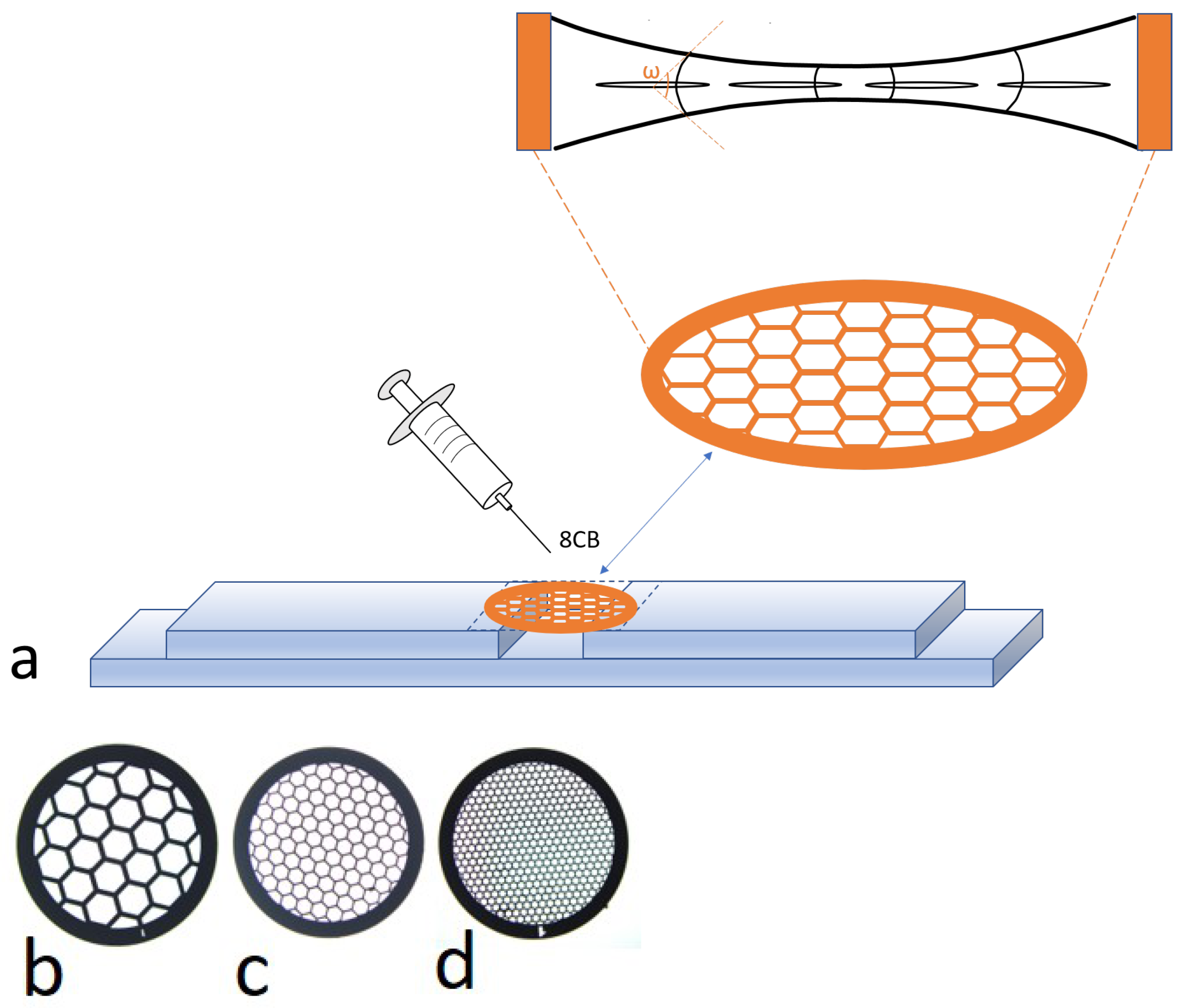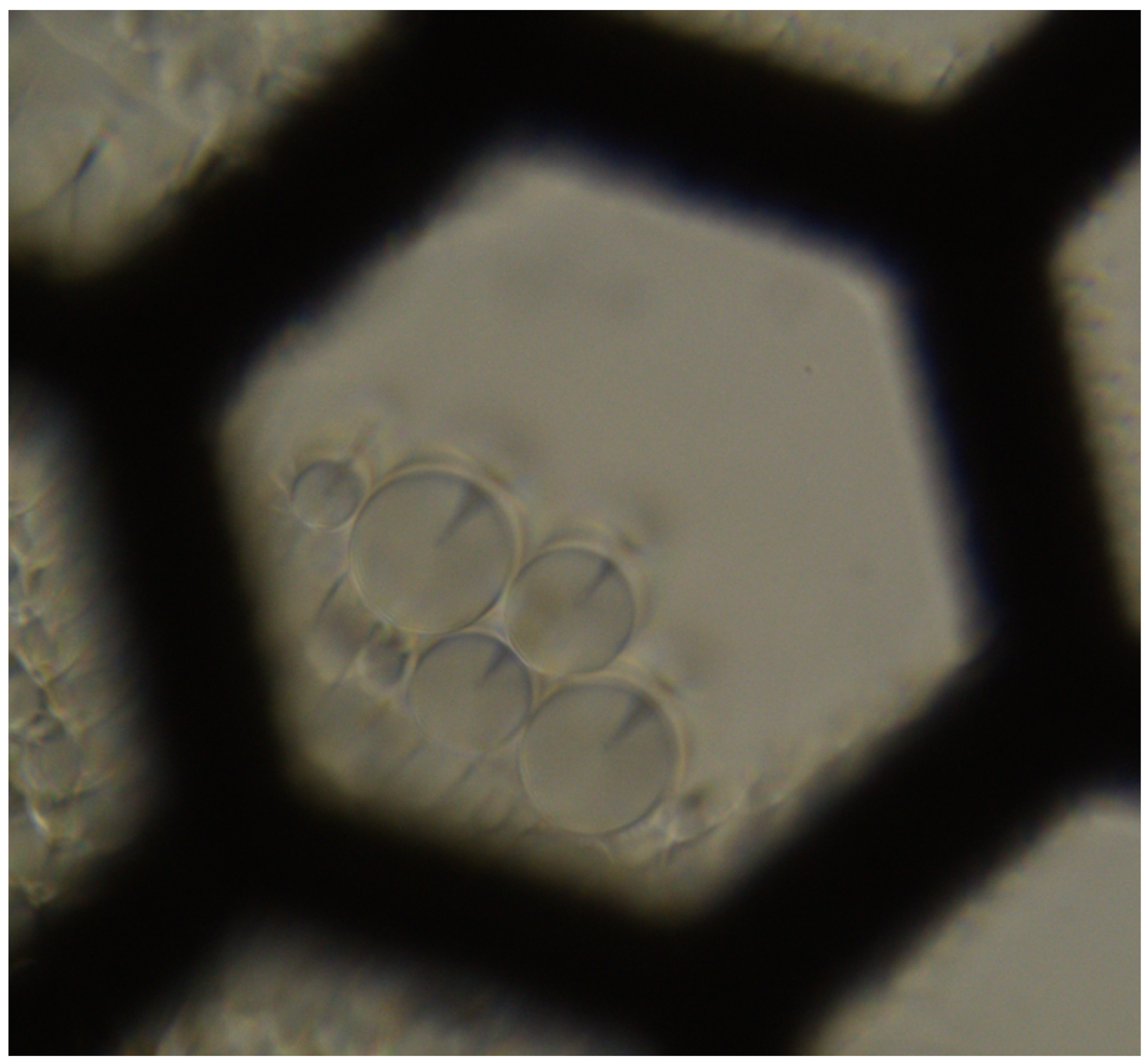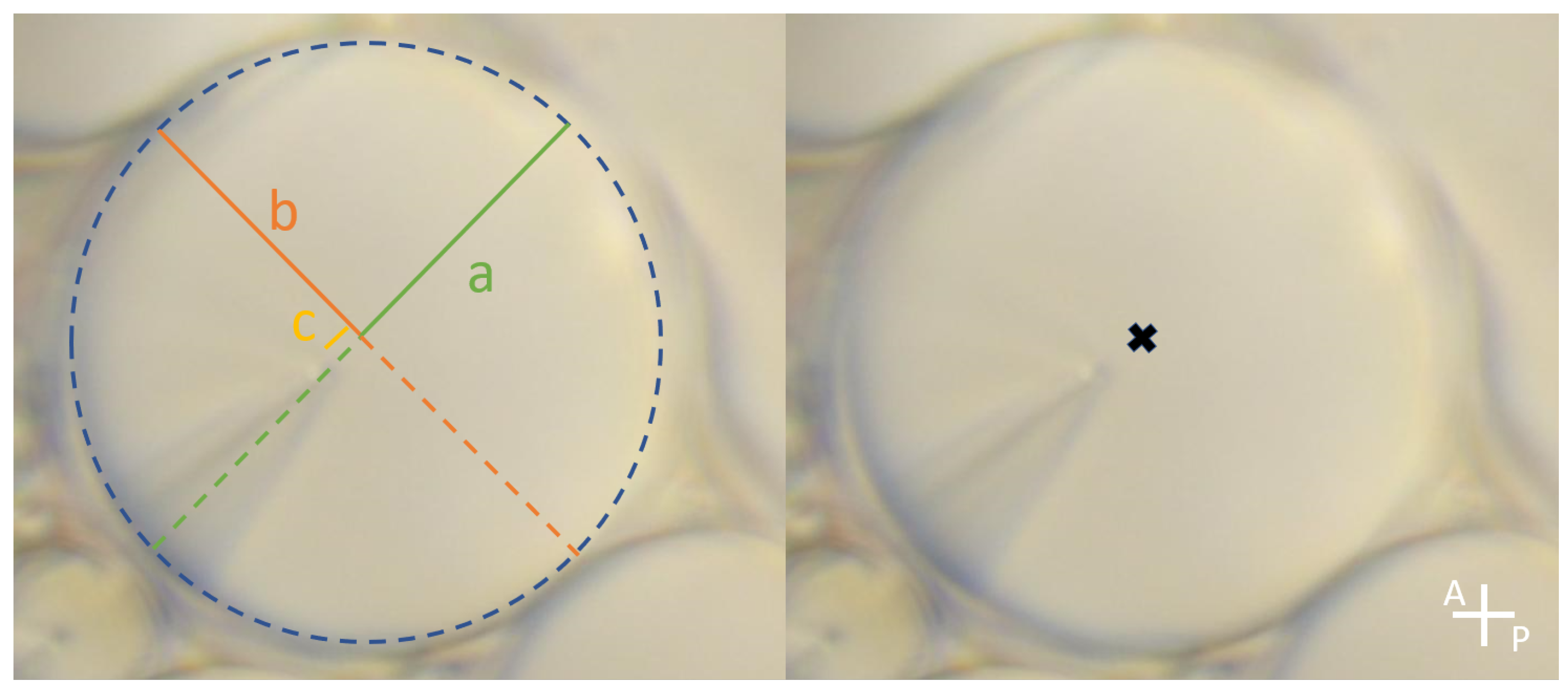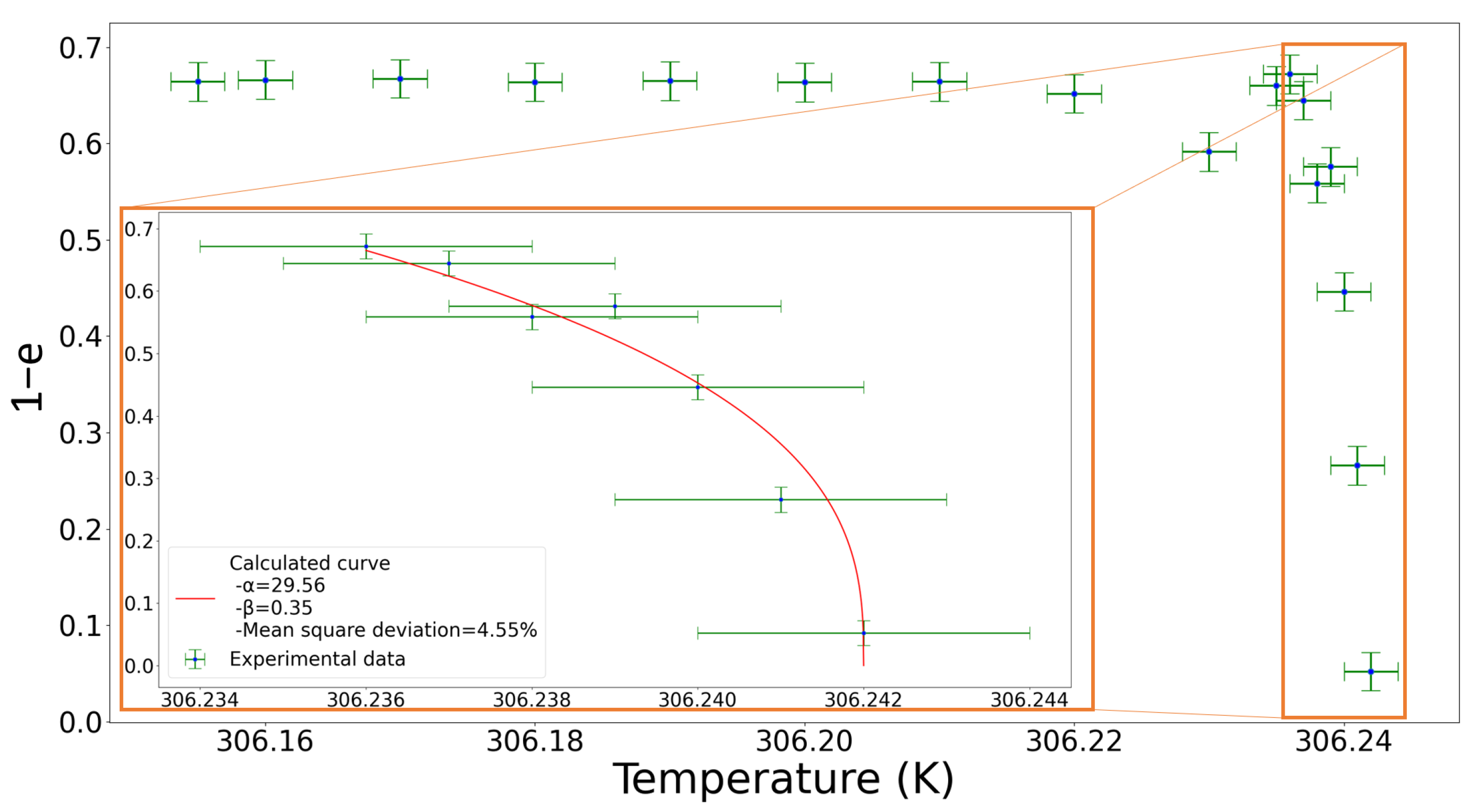Evolution of Focal Conic Domains in SmA-N Phase Transition
Abstract
:1. Introduction
2. Experimental Protocol
3. Observations
- The ellipse has an almost circular shape when the latter is isolated from other focal conics (see Figure 4a); the shape is well-defined and can therefore be precisely measured. With an elliptical shape, the semi-minor axis a and the semi-major axis b can be obtained with ImageJ Software, see Figure 3 for an example. The apex of the hyperbola is also visible in this picture, so that we can check our estimation of the ellipse size with the measured value of the focus distance c, the measured value being given by . To estimate the errors, a series of 20 manual measurements was performed on the same focal conic. The uncertainty was determined by the deviations between the measurements.
- Each focal conic completely disappears and seems to, under the observation conditions used, leave no visible trace.
- The increase in eccentricity is a very rapid phenomenon, of the order of 0.02 s at the most.
4. Model
5. Discussion
6. Conclusions
Supplementary Materials
Author Contributions
Funding
Institutional Review Board Statement
Informed Consent Statement
Data Availability Statement
Acknowledgments
Conflicts of Interest
Abbreviations
| FCD | Focal Conic Domain |
References
- Frank, F.C.I. Liquid crystals. On the theory of liquid crystals. Discuss. Faraday Soc. 1958, 25, 19–28. [Google Scholar] [CrossRef]
- Grandjean, F.; Friedel, G. Observations géométriques sur les liquides à coniques focales. Bull. De Minéralogie 1910, 33, 409–465. [Google Scholar] [CrossRef]
- Kleman, M.; Lavrentovich, O.D. Soft Matter Physics: An Introduction; Springer: New York, NY, USA, 2003. [Google Scholar] [CrossRef]
- Kleman, M.; Lavrentovich, O.D. Liquids with conics. Liq. Cryst. 2009, 36, 1085–1099. [Google Scholar] [CrossRef]
- Nastishin, Y.A.; Meyer, C. Imperfect defects in smectics A. Liq. Cryst. Rev. 2023, 11, 19–47. [Google Scholar] [CrossRef]
- Rosenblatt, C.S.; Pindak, R.; Clark, N.A.; Meyer, R.B. The parabolic focal conic: A new smectic a defect. J. Phys. 1977, 38, 1105–1115. [Google Scholar] [CrossRef]
- Williams, C. DÉFAUTS LINÉAIRES DES MÉSOPHASES SMECTIQUES A. J. Phys. Colloq. 1978, 39, C2-48–C2-57. [Google Scholar] [CrossRef]
- Williams, P.C.E.; Kleman, M. Sur passociation des lignes de dislocations vis et des coniques focales dans les smectiques A. Philos. Mag. 1976, 33, 213–217. [Google Scholar] [CrossRef]
- Meyer, C.; Nastishin, Y.; Kleman, M. Helical defects in smectic-A and smectic-A* phases. Phys. Rev. E 2010, 82, 031704. [Google Scholar] [CrossRef] [PubMed]
- Meyer, C.; Rabette, C.; Gisse, P.; Antonova, K.; Dozov, I. DH* in chiral smectics under electric field. Eur. Phys. J. E 2016, 39, 76. [Google Scholar] [CrossRef] [PubMed]
- Kamien, R.D.; Nastishin, Y.; Pansu, B. Geometry of focal conics in sessile cholesteric droplets. Proc. Natl. Acad. Sci. USA 2023, 120, e2311957120. [Google Scholar] [CrossRef]
- Gim, M.J.; Beller, D.A.; Yoon, D.K. Morphogenesis of liquid crystal topological defects during the nematic-smectic A phase transition. Nat. Commun. 2017, 8, 15453. [Google Scholar] [CrossRef]
- Lochon, F. Propriétés Optiques de Nanoparticules Plasmoniques et de Cristaux Liquides pour Applications aux Vitrages Intelligents. Ph.D. Thesis, Thèse de doctorat, Olivier Lasers, Matière et Nanosciences. Université de Bordeaux, Bordeaux, France, 2022. [Google Scholar]
- Boniello, G.; Vilchez, V.; Garre, E.; Mondiot, F. Making Smectic Defect Patterns Electrically Reversible and Dynamically Tunable Using In Situ Polymer-Templated Nematic Liquid Crystals. Macromol. Rapid Commun. 2021, 42, 2100087. [Google Scholar] [CrossRef] [PubMed]
- Mahyaoui, C.N.; Davidson, P.; Meyer, C.; Dozov, I. Polymerisation of twist-bend nematic textures for electro-optical applications. Soft Matter 2024, 20, 4859–4867. [Google Scholar] [CrossRef]
- Luo, D.; Wu, J.; Guo, Z.; Xia, J.; Hu, W. Generation and regularization of zigzag focal conic domains guided by thermodynamic-driven topological defect evolution. Giant 2024, 20, 100327. [Google Scholar] [CrossRef]
- Yoon, D.; Choi, M.; Kim, Y.H.; Kim, M.; Lavrentovich, O.; Jung, H.T. Internal structure visualization and lithographic use of periodic toroidal holes in liquid crystals. Nat. Mater. 2007, 6, 866–870. [Google Scholar] [CrossRef]
- Meyer, C.; Kleman, M. How Do Defects Transform at the Smectic A-Nematic Phase Transition? Mol. Cryst. Liq. Cryst. 2005, 437, 1355–1363. [Google Scholar] [CrossRef]
- Kléman, M.; Lavrentovich, O. Grain boundaries and the law of corresponding cones in smectics. Eur. Phys. J. E 2000, 2, 47–57. [Google Scholar] [CrossRef]
- Meyer, C.; Le Cunff, L.; Malika, B.; Foyart, G. Focal Conic Stacking in Smectic A Liquid Crystals: Smectic Flower and Apollonius Tiling. Materials 2009, 2, 499. [Google Scholar] [CrossRef]
- Stanley, H. Introduction to Phase Transitions and Critical Phenomena; International Series of Monographs on Physics; Oxford University Press: Oxford, UK, 1987; p. 11. [Google Scholar]






Disclaimer/Publisher’s Note: The statements, opinions and data contained in all publications are solely those of the individual author(s) and contributor(s) and not of MDPI and/or the editor(s). MDPI and/or the editor(s) disclaim responsibility for any injury to people or property resulting from any ideas, methods, instructions or products referred to in the content. |
© 2025 by the authors. Licensee MDPI, Basel, Switzerland. This article is an open access article distributed under the terms and conditions of the Creative Commons Attribution (CC BY) license (https://creativecommons.org/licenses/by/4.0/).
Share and Cite
Plée, V.; Lacam, J.; Pascoli, G.; Meyer, C. Evolution of Focal Conic Domains in SmA-N Phase Transition. Materials 2025, 18, 711. https://doi.org/10.3390/ma18030711
Plée V, Lacam J, Pascoli G, Meyer C. Evolution of Focal Conic Domains in SmA-N Phase Transition. Materials. 2025; 18(3):711. https://doi.org/10.3390/ma18030711
Chicago/Turabian StylePlée, Vincent, Jordan Lacam, Gianni Pascoli, and Claire Meyer. 2025. "Evolution of Focal Conic Domains in SmA-N Phase Transition" Materials 18, no. 3: 711. https://doi.org/10.3390/ma18030711
APA StylePlée, V., Lacam, J., Pascoli, G., & Meyer, C. (2025). Evolution of Focal Conic Domains in SmA-N Phase Transition. Materials, 18(3), 711. https://doi.org/10.3390/ma18030711






